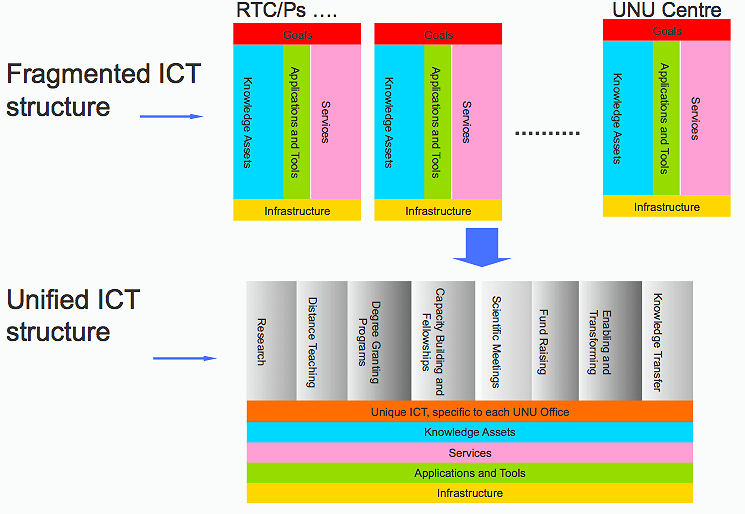Vision
The University encompasses 13 institutes located in 12 countries (aka Research and Training Centres and Programs (RTCPs)) around the world. As a global organization, UNU’s competitive edge depends in large part on its ability to coordinate critical resources that are spread across different geographical locations. The UNU Global Office (GO) initiative contributes to this objective by harmonizing and standardizing information and communications technology (ICT) university-wide, enabling pooling of resources and eliminating redundant processes and systems.

In the 21st century, the working style of staff is increasingly mobile and flexible. The vision of Global Office seeks to provide a foundation on which technology services can be built to enable UNU staff and students with a productive, user friendly computing environment that is consistent regardless of location and device.
Why we do it?
The drivers include, but are not limited to the following:
Internal drivers
- Duplication of effort, data and systems
- Incompatible data, processes and systems hindering the ability to reuse, repurpose and share resources seamlessly and effectively
- Partial migration of UNU administration to Malaysia
- Establishment of the Vice Rectorship in Europe
- Uniformity and consistency of ICT services facilitates staff mobility
External drivers
- Advances in networking and consolidation technologies are making it possible for the University to deliver ICT services across the organization through a reduced number of data centers
- UN calls for system-wide coherence, a repositioned UN, delivering as one
Financial drivers
- With ever shrinking resources, UNU is seeking greater returns from investments in ICT through better utilization and management of ICT resources
Thematic drivers
- Inter-disciplinary research projects require teams of specialists collaborating, sharing ideas and coordinating efforts
Strategic drivers
- Overcome systemic fragmentation to achieve coherence and consolidation of UNU activities
- Strengthen branding and ICT capacity across UNU
- Support for the twinning institutes strategy and further expansion of UNU, where institutes have the flexibility to find the right mix local and shared services to cater to their ICT requirements.
Approach
To realize this vision, we pursue an implementation approach that is best characterized by a shared services model, which draws from the best of centralization (economies of scale, efficiency, standardization) and decentralization (local control, flexibility, user-focused). Common services such as authentication, email, business processes, collaboration and document management platforms are good candidates for re-engineering into shared services.
The modus operandi of GO is based on the principle of free-will association and cooperation. Since its inception in 2009, all UNU locations have been successfully added to the Global Office with varying degrees of integration.
Benefits
- Single user-ID and password to consume local and UNU-wide intranet resources,
- Reduction of duplication of effort/data/incompatible systems,
- Strengthening of the overall ICT capacity by aggregating the independent ICT units into a 24/7 global team,
- Cost savings through consolidation of ICT resources while maintaining strong respect to local differentiation when required,
- Management can release resources to focus on the unique requirements and core specialized businesses rather than building everything from scratch,
- Simplification of sharing, repurposing and reuse of information throughout the University,
- Enhancement of staff mobility within UNU without requiring the staff to relearn new technology interfaces when they travel between offices.